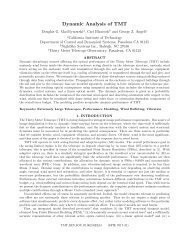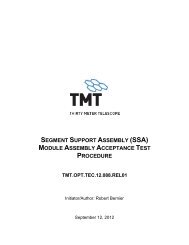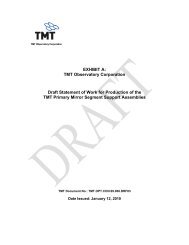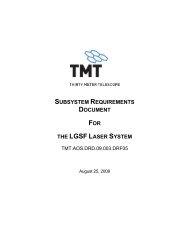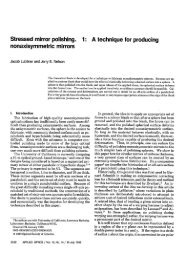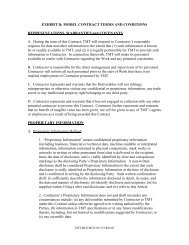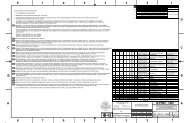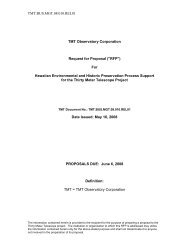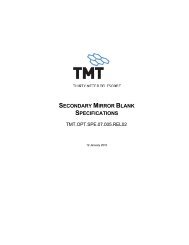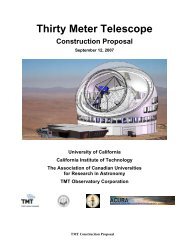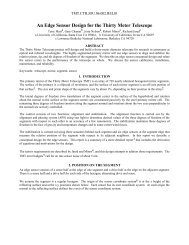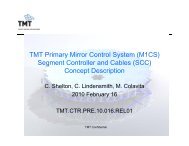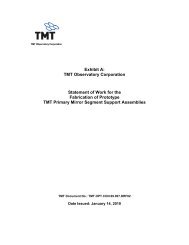Advancement of the Segment Support System - Thirty Meter Telescope
Advancement of the Segment Support System - Thirty Meter Telescope
Advancement of the Segment Support System - Thirty Meter Telescope
Create successful ePaper yourself
Turn your PDF publications into a flip-book with our unique Google optimized e-Paper software.
<strong>the</strong> optimum solution is not exactly where <strong>the</strong> ratio is 6:1, but nearby. The Zernike decomposition <strong>of</strong> this new minimum,<br />
(re-optimized) is shown in Table 1c.<br />
The absolute difference in <strong>the</strong> Zernike coefficients between <strong>the</strong> classical result (1a) and <strong>the</strong> re-optimized design (1c) is<br />
shown in Table 1d. Note that this new solution has significantly less Primary Astigmatism, Coma, and Tertiary Coma.<br />
For <strong>the</strong> terms shown, only a few terms show small increases in amplitude. These results demonstrate that <strong>the</strong> approach<br />
significantly reduces global bending at no o<strong>the</strong>r apparent optical consequence.<br />
Uncorrected Zernike Amplitudes (nm)<br />
for 1g lateral (Dashed lines)<br />
20<br />
0<br />
-20<br />
-40<br />
-60<br />
-80<br />
-100<br />
Diaphragm CL at 1.755 mm<br />
Ast./Coma = 4.15<br />
RMS = 12.0 nm<br />
Uncorrected RMS = 20.8 nm (min.)<br />
60<br />
50<br />
40<br />
30<br />
20<br />
10<br />
0<br />
Surface RMS (nm) or Astig/Coma Ratio<br />
(Solid lines)<br />
-120<br />
-1.0 -0.5 0.0 0.5 1.0 1.5 2.0 2.5<br />
Diaphragm centerline (CL) position relative to mirror neutral axis, mm<br />
(Positive direction is away from optical surface)<br />
-10<br />
Coma<br />
RMS (Uncorrected)<br />
Astigmatism/Coma Ratio<br />
Astigmatism<br />
RMS (Corrected by whiffletree moments)<br />
Thermal Distortion RMS for 5 deg C change<br />
Figure 7<br />
Results for 1g X loading: astigmatism, coma, astigmatism to coma ratio (all before correction);<br />
surface RMS corrected and uncorrected. Thermal distortion for 5°C temperature change. All<br />
predictions as a function <strong>of</strong> diaphragm position. (Piston/Tip/Tilt subtracted)<br />
Also shown in Figure 7 is <strong>the</strong> predicted <strong>the</strong>rmal distortion resulting from an iso<strong>the</strong>rmal temperature change applied to<br />
<strong>the</strong> segment and SSA. The <strong>the</strong>rmal distortion arises because <strong>of</strong> <strong>the</strong> coefficient <strong>of</strong> <strong>the</strong>rmal expansion (CTE) mismatch<br />
between <strong>the</strong> SSA and <strong>the</strong> glass. The analysis assumes a 5°C temperature change, which is representative <strong>of</strong> <strong>the</strong><br />
statistical variations about <strong>the</strong> median observing temperature at <strong>the</strong> site. It is noted that <strong>the</strong> <strong>the</strong>rmal distortion decreases<br />
as <strong>the</strong> diaphragm is shifted slightly away from <strong>the</strong> optical surface, over this range <strong>of</strong> diaphragm positions. This effect is<br />
an additional benefit <strong>of</strong> utilizing <strong>the</strong> new minimum.<br />
Ano<strong>the</strong>r design option that was considered is to position <strong>the</strong> diaphragm such that <strong>the</strong> <strong>the</strong>rmal distortion is minimized.<br />
Such a solution was explored, and it was found that <strong>the</strong> <strong>the</strong>rmal distortion could be driven close to zero, but at <strong>the</strong><br />
expense <strong>of</strong> large lateral gravity distortions. Since <strong>the</strong> optical performance <strong>of</strong> <strong>the</strong> telescope is more sensitive to high<br />
frequency errors, such as lateral distortion, it is clear that this approach does not provide a preferred solution for TMT.



